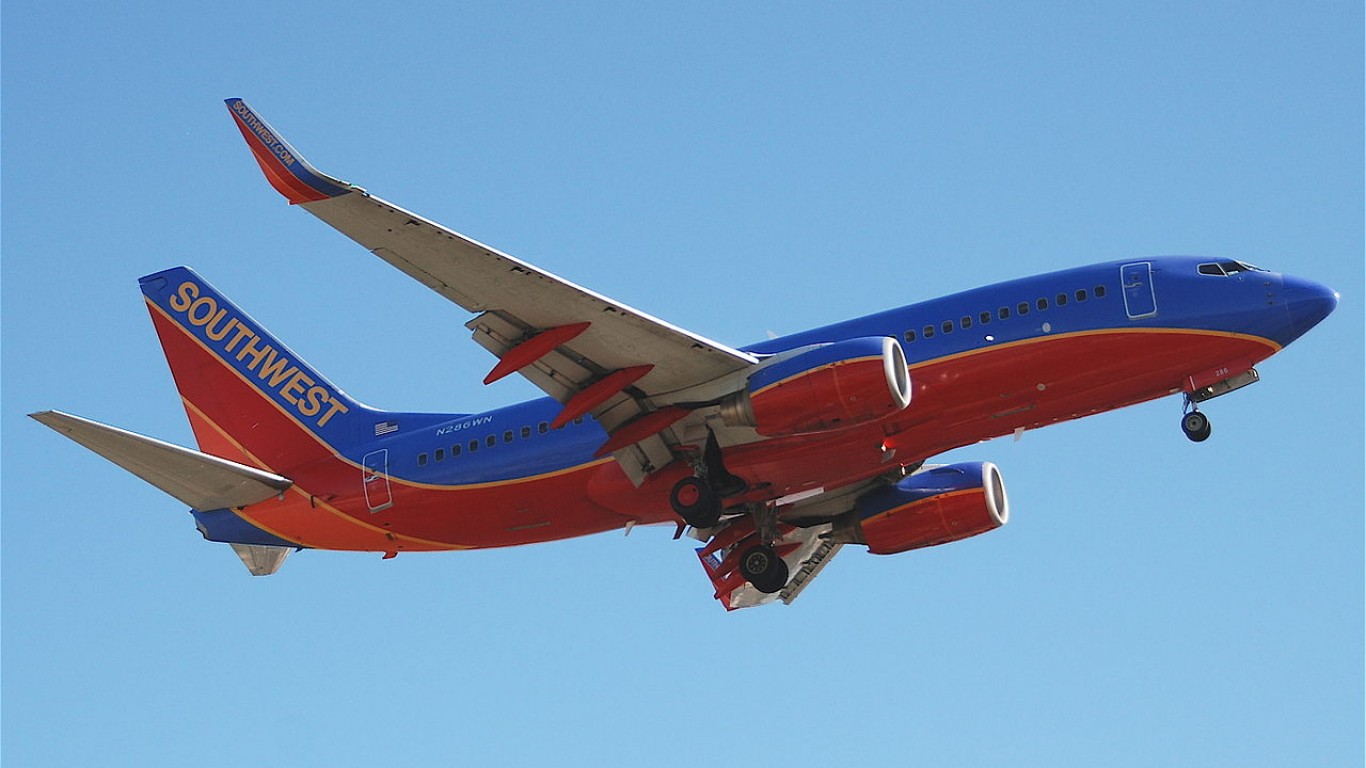
Last year was probably the toughest in recent history on airline stocks. Stay-at-home orders in many parts of the world, combined with a moribund economy and people’s fear of being infected with COVID-19, reduced air passenger traffic by as much as 80%.
While the industry is still far from full recovery, it’s getting closer. Last Sunday, the U.S. Transportation Security Administration reported that 1.98 million passengers went through the nation’s airports, the highest total in more than a year, but still more than 600,000 fewer than on the same date in 2019.
[in-text-ad]
We screened the major U.S. carriers to determine which had the most Buy and Strong Buy ratings from analysts and which appear to be on track for solid gains over 2021 and 2022.
Southwest Airlines
Low-cost carrier Southwest Airlines Co. (NYSE: LUV) has garnered 16 Buy or Strong Buy ratings from brokerage analysts. At the end of the March quarter, Southwest reported long-term debt totaling $10.55 billion, an order of magnitude greater than the company reported in December of 2019. Cash flow from operations in the March quarter amounted to a loss of $105 million, but, again, an order of magnitude smaller than the $1.1 billion loss in the December 2020 quarter.
To give you an idea of how far Southwest and other carriers have to come back, in the December 2019 quarter, operating cash flow totaled nearly $4 billion.
Using enterprise value-to-sales (EV/Sales) as a measure, Southwest’s multiple is 2.2 times expected 2021 sales and drops to 1.6 times expected 2022 sales. The average price target on the stock is $69.16, and shares currently trade at around $57.85, implying an upside potential of nearly 20%. Southwest suspended its quarterly dividend of $0.18 per share beginning in the second quarter of last year.
Shares are forecast to post a 2021 loss of $1.56, while 2022 earnings per share (EPS) is expected to come in at $3.18. The stock’s 52-week trading range is $30.24 to $64.75. S&P Capital IQ has a consensus estimate for a June quarter per-share loss of $0.39 on sales of $3.84 billion.
Alaska Airlines
Alaska Air Group Inc. (NYSE: ALK) has received 12 Buy or Strong Buy ratings from analysts. At the end of the March quarter, the company reported long-term debt of $2.33 billion, less than double its total at the end of the December 2019 quarter. Operating cash flow was a negative $100 million, compared with a positive total of $1.72 billion in the last quarter of 2019 and a negative cash flow of $234 million in the December 2020 quarter.
The stock is forecast at a multiple of 1.6 times EV/Sales in 2021 and 1.2 times in 2022. The average price target on the shares is $83.77. With the stock currently trading around $65.15, upside potential is about 28.5%. Alaska Air suspended its quarterly dividend of $0.375 following the first quarter of last year.
The stock is forecast to post a loss per share of $3.05 in 2021, recovering to EPS of $4.77 in 2022. The stock’s 52-week range is $33.00 to $74.25. S&P Capital IQ has a consensus estimate for a June quarter per-share loss of $0.80 on sales of $1.51 billion.
Delta Air Lines
Of 22 firms covering Delta Air Lines Inc. (NYSE: DAL), 11 rate the stock a Buy or Strong Buy, with another 10 having a Hold rating. At the end of the March quarter, Delta reported $24.8 billion in long-term debt, triple the level in December of 2019. Operating cash flow was a negative $3.46 billion, compared with operating cash flow of a positive $8.43 billion in the December 2019 quarter. In the December 2020 quarter, operating cash flow was $3.79 billion.
[in-text-ad]
Analysts project an EV/Sales multiple of 1.9 times in 2021 and 1.4 times in 2022. The average price target on the stock is $55.10, and the current price is around $46.50. At that price, upside potential based on the average target is about 18.5%. Delta suspended its quarterly dividend of $0.4025 in the second quarter of last year.
The expected per-share loss in fiscal 2021 is $3.66 per share, while the stock is forecast to post EPS of $3.89 in 2022. The stock’s 52-week range is $24.38 to $52.28. S&P Capital IQ has a consensus estimate for a June quarter per-share loss of $1.43 on sales of $6.2 billion.
United Airlines
Ten of 21 firms covering United Airlines Holdings Inc. (NASDAQ: UAL) rate the stock a Buy or Strong Buy, while seven rate the stock a Hold. United is clearly viewed as the riskiest of these four carriers. At the end of the March quarter, United’s long-term debt of $25.85 billion was slightly less than double its pre-pandemic level of $13.15 billion. The airline’s operating loss in the March quarter totaled $3.75 billion compared with a profit of $6.91 billion in the December 2019 quarter.
Analysts forecast an EV/Sales multiple of 1.8 times for 2021 and 1.2 times for 2022. United suspended its dividend in 2019. The average price target on the stock is $59.45, and the shares currently traded at around $56.60, implying potential upside of about 5.3%.
United’s expected per-share loss in fiscal 2021 is $13.18. In 2022, the airline is expected to post EPS of $3.28. The stock’s 52-week range is $29.23 to $63.70. S&P Capital IQ has a consensus estimate for a June quarter per-share loss of $4.44 on sales of $5.15 billion.
100 Million Americans Are Missing This Crucial Retirement Tool
The thought of burdening your family with a financial disaster is most Americans’ nightmare. However, recent studies show that over 100 million Americans still don’t have proper life insurance in the event they pass away.
Life insurance can bring peace of mind – ensuring your loved ones are safeguarded against unforeseen expenses and debts. With premiums often lower than expected and a variety of plans tailored to different life stages and health conditions, securing a policy is more accessible than ever.
A quick, no-obligation quote can provide valuable insight into what’s available and what might best suit your family’s needs. Life insurance is a simple step you can take today to help secure peace of mind for your loved ones tomorrow.
Click here to learn how to get a quote in just a few minutes.
Thank you for reading! Have some feedback for us?
Contact the 24/7 Wall St. editorial team.


